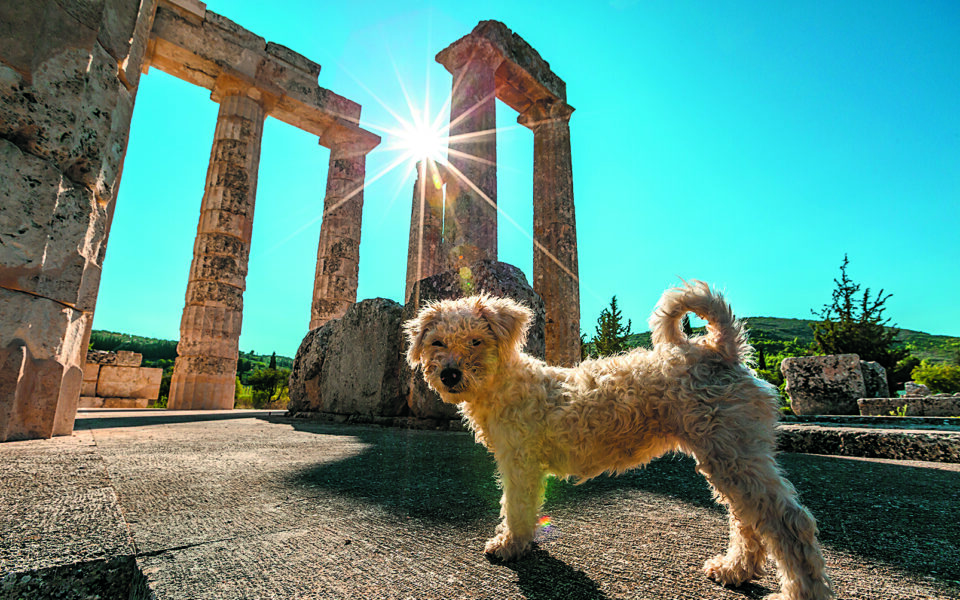Should pets be allowed inside archaeological sites with their humans?

Pets are allowed on public transport, ferries and planes, but as the presence of companion animals in daily life has increased, one more question has arisen, particularly in view of the tourist season: Should they be allowed in archaeological sites? And if so, under what conditions?
The issue was raised for the first time at a meeting of Greece’s top advisory body on the protection of antiquities, the Central Archaeological Council (KAS), on April 11, and it was discussed again at another meeting on Wednesday. The parameters discussed in the first meeting included what applies in other countries and whether vulnerable areas and those protected by UNESCO will be excluded, among others. Currently, existing Greek law prohibits animals from entering archaeological sites, with the exception of guide dogs.
Panagiotis Valavanis, emeritus professor of Classical archaeology at the University of Athens, and Angeliki Kottaridis, head of the Imathia Ephorate of Antiquities, present their opinions to Kathimerini.
The necessary tranquility
BY PANAGIOTIS VALAVANIS
In ancient times, the entry and accommodation of companion animals at sanctuaries was prohibited, perhaps because it was believed their presence polluted the space and prevented ritual acts from taking effect.
As the historian Philochorus of Athens reported, in the summer of 306 BC, a female dog escaped the attention of the guards, entered the Acropolis and climbed onto the altar of Zeus Herkeios, under the sacred olive tree of Athena, where the priests found the dog sleeping.
The event worried the Athenians, just as it would worry Christians today if a dog entered the sanctuary of a church and lay on top of the altar. The religious Philochorus, who also performed the duties of diviner and interpreter of the council of the gods, requested that the altar and the entire Erechtheion be cleansed immediately, so that it would be freed from the “miasma” of the animal.
However, there were also cases where the prohibition did not apply, such as at ancient sanatoriums, the asclepieia. The fact that dog saliva has antibacterial properties seems to have unconsciously led the Greeks, who did not know about bacteria, to attribute healing powers to these animals. Thus, at the sanctuaries of Asclepius, dogs were housed as part of the staff. In fact, in depictions of the god of medicine himself on coins from Epidaurus, Asclepius is represented with his symbols, the scepter and the snake, sitting on a stool, with a dog lying underneath.
Today, our relationship with companion animals has changed drastically, especially in recent years, resulting in more and more claims on the part of their animal-loving protectors. Without wanting to take away any of the rights of our fellow citizens who love both antiquities and animals, I think that we should remain true to the perceptions and practices of ancient Greeks.
Not only because animals could urinate and defecate in the sites, with obvious unpleasant effects on monuments and people, but mainly so as not to disturb the tranquility necessary for our meaningful contact with the monuments.
Panagiotis Valavanis is emeritus professor of Classical archaeology at the National and Kapodistrian University of Athens.
The responsibility of owners
BY ANGELIKI KOTTARIDIS
I returned this week from a 10-day trip to Turkey. I traveled to the ancient cities of Ephesus, Laodicea on the Lycus, Aphrodisias, Miletus and Priene, and visited four museums and 12 very important archaeological sites. I was greeted everywhere by well-behaved and completely tame dogs and cats, most with the distinguishing mark of veterinary care on their ear, playing and being petted by the visitors.
In the Aphrodisias Museum there were two adorable kittens, and in the visitors’ seating area of the Miletus Museum, a magnificent cat was enthroned. None of the visitors seemed bothered by their presence – quite the opposite.
In Greece, unfortunately, we are still debating whether cat-sized dogs and cats in cages should be allowed to accompany their humans inside the open-air and usually vast archaeological sites. We even hear arguments such as a risk of allergies or phobic reactions from other visitors which, given the supervision of companion animals and the responsibility of owners, just don’t make any sense.
Knowing first-hand the enormous difficulty that current strict regulations create for animal-loving visitors, I believe they should have already been repealed and dogs and cats should be allowed to follow their owners around archaeological sites, without even the proposed restrictions (allowing dogs weighing up to 10 kg and a maximum height of 40 cm). According to existing legislation, owners are always fully responsible for the behavior of their four-legged friends, and this obviously applies when it comes to archaeological sites as well. In fact, I believe that small dogs, guide dogs and cats (let’s remember the cats residing in the Hermitage Museum in Saint Petersburg, Russia) should also be allowed inside the museums, always under the supervision of their owners.
And after we’re done with doing the obvious, let’s actually get down to solving the real problem, which is the strays. We can and must finally take care of them, in cooperation with municipal authorities, as befits those who want to be considered civilized people. After all, animals tame us.
Angeliki Kottaridis is head of the Imathia Ephorate of Antiquities.





